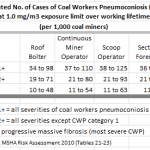silica
OSHA took the long road to adopt a standard to address respirable crystalline silica. Although the final rule was issued in March 2016, it is being challenged by both industry and labor groups. The first says OSHA went too far, the other says OSHA didn’t go far enough.
The long road, however may be coming close to end. The U.S. Court of Appeals for the District of Columbia Circuit heard oral arguments last week from parties that are challenging the rule. Judges Merrick Garland, David Tatel and Karen LeCraft Henderson spent more than two hours listening to arguments from the National Stone,…
President Trump’s nominee to head the Labor Department’s Mine Safety and Health Administration (MSHA) appeared today before a Senate committee for a confirmation hearing. David Zatezalo answered questions about the epidemic of black lung cases, an increase in mine worker fatalities, the need for safety assistance for small mine operators, and more. Zatezalo began his career in 1974 as a UMWA coal miner and most recently served as chairman of Rhino Resources.
I watched the webcast of Zatezalo's confirmation hearing. The nominee noted his experience managing 39 different coal mines in the…
I felt a little like Claude Rains (as Capt. Louis Renault) in the film Casablanca. He's the actor with the famous line "I'm shocked, shocked to find that gambling is going on here." On Sunday my neighbor asked me: “What do you think about all those coal miners with black lung?”
“Shocked, shocked,” I was tempted to say, but I’m not the least bit shocked.
My neighbor was referring to the latest story by NPR’s Howard Berkes about nearly 2,000 cases of progressive massive pulmonary fibrosis (PMF) diagnosed in the last six years among Appalachian coal miners. Two thousand cases is a hefty…
At the Center for Public Integrity, Talia Buford and Maryam Jameel investigate federal contractors that receive billions in public funds despite committing wage violations against their workers. In analyzing Department of Labor data on more than 1,100 egregious violators, the reporters found that federal agencies modified or granted contracts totaling $18 billion to 68 contractors with proven wage violations. The Department of Defense contracted with the most wage violators.
Under Obama, labor officials had attempted to address the problem with the Fair Pay and Safe Workplaces rule, which…
My favorite line from today’s Senate hearing on the nomination of Alex Acosta to be Labor Secretary came from Senator Elizabeth Warren:
“The test for Secretary of Labor is not: are you better than Andrew Puzder.”
Puzder was Trump’s first pick for the job. He had a long list of problems that made him unfit for the position. So instead of Puzder, the Senate Committee on Health, Education, Labor and Pensions is considering the nomination of Alex Acosta. The 48-year old is currently dean of the College of Law at Florida International University. He also served as U.S. Attorney for the Southern…
I’m still haunted by the voice on my car radio. It was one of those “NPR moments.”
We were parked at our destination, but there was no way we were getting out of the car. National Public Radio’s (NPR) Howard Berkes was reporting from eastern Kentucky and interviewing Mackie Branham. The 39 year old coal miner gasped for air over every word. Chills ran up my spine. Branham's lungs were hardened by coal mine dust. It was painful to listen yet the perfect punctuation for a powerful story.
Berkes’ reported findings of an NPR investigation of the incidence of the most severe form of coal workers’…
Mining is one of the most dangerous jobs in America, with more than 600 workers dying in fatal workplace incidents between 2004 and the beginning of July. And many more miners die long after they’ve left the mines from occupational illnesses such as black lung disease, while others live with the debilitating aftermath of workplace injuries. Today, researchers know a great deal about the health risks miners face on the job, but some pretty big gaps remain.
Kristin Yeoman and her colleagues at the National Institute for Occupational Safety and Health (NIOSH) hope to begin closing that knowledge…
“Bad math” and “slippery language” is how Rep. Mark Pocan (D-WI) characterized some of the testimony at this week’s congressional hearing on OSHA’s silica regulation. It was a hearing before the Subcommittee on Workforce Protections of the House Committee on Education and the Workforce, and scheduled as a platform for complaints about the new OSHA rule. The agency announced the rule on March 25 and it is designed to protect workers who are exposed to respirable crystalline silica.
Moans and groans about the OSHA rule were offered by representatives of the US Chamber of Commerce, the…
Last Thursday, OSHA announced a new standard to protect workers who are exposed to respirable crystalline silica. Here are some of my favorite quotes and remarks in response to OSHA's news:
“Safety advocates worked for years to get this rule in place. Controlling silica dust is especially important to immigrant workers and other vulnerable groups, who are often assigned the dirtiest, most dangerous jobs on any worksite.” Javier Garcia Hernandez, a construction worker and former consultant for the Philadelphia Area Project on Occupational Safety and Health. (here)
“[Obama] administration…
This post is dedicated to J.T. Knuckles. He died in 1998 at age 58 from silicosis.
JT Knuckles, foundry worker from Saginaw, MI (1996).
I first met J.T. Knuckles in 1996. He spoke at a press event at which former Labor Secretary Robert Reich announced a national campaign to eliminate silicosis. “If it’s silica, it’s not just dust” was the campaign slogan. Today, 20 years after I met J.T. Knuckles, current Labor Secretary Tom Perez announced an OSHA standard designed to prevent silicosis.
I watched this morning a live stream of Secretary Perez's announcement. He shared some of…
**Update below (1/30/2016)
A new paper by NIOSH researchers explores the use of lung transplants for individuals with work-related pneumoconiosis, including black lung disease. Using data from the United Network for Organ Sharing (UNOS) for the period 1996-2014, Blackley and colleagues identified 47 lung-transplant cases in which the patient’s primary diagnosis was “coal workers’ pneumoconiosis” or pneumoconiosis unspecified.” Thirty four of the lung transplants (72%) were performed since 2008.
The medical costs for a bilateral lung transplant are substantial. In 2014, the average cost of…
During the holiday season, Kim, Liz and I are taking a short break from blogging. We are posting some of our favorite posts from the past year. Here’s one of them, originally posted on July 27, 2015:
by Celeste Monforton, DrPH, MPH
The occupational health community, coal miners, their families and labor advocates are mourning the loss of physician Donald Rasmussen, 87.
For more than 50 years, he diagnosed and treated coal miners with work-related lung disease, first at the then Miners Memorial Hospital in Beckley, WV and later at his own black lung clinic. A lengthy story by John…
At the Center for Public Integrity, reporters Jim Morris and Maryam Jameel investigate the nation’s “third wave” of asbestos-related disease. The story begins with two photos of Kris Penny, who used to install fiber-optic cable beneath the streets of Florida.
The first photo is of Penny in April 2015, looking healthy and happy. The next photo is one taken just six months later. Penny looks dramatically transformed after being diagnosed with peritoneal mesothelioma, a rare cancer of the abdominal lining that’s nearly always related to asbestos exposure. After talking with a lawyer, Penny…
The U.S. Occupational Safety and Health Administration is no stranger to budget cuts — the agency is already so underfunded that it would take its inspectors nearly a century, on average, to visit every U.S. workplace at least once. In some states, it would take two centuries. Unfortunately, appropriations bills now making their way through Congress don’t bode much better for OSHA.
Earlier this month, the National Council for Occupational Safety and Health (National COSH) and Public Citizen, along with 74 fellow organizations that care about worker health and safety, sent a letter to…
[Updated below (8/3/15)]
The occupational health community, coal miners, their families and labor advocates are mourning the loss of physician Donald Rasmussen, 87.
For more than 50 years, he diagnosed and treated coal miners with work-related lung disease, first at the then Miners Memorial Hospital in Beckley, WV and later at his own black lung clinic. A lengthy story by John Blankenship in Beckley’s Register-Herald written two years ago profiled Dr. Rasmussen’s career.
“ In 1962, a young doctor from Manassa, Colorado, saw a help wanted advertisement in a medical journal needing doctors in…
This week, the Center for Public Integrity launched a new investigative series into the failure of regulators to protect workers for toxic exposures. The series begins with the story of a bricklayer who developed acute silicosis after exposure to silica, a deadly substance that threatens more than 2 million workers and that OSHA has been struggling to regulate for 40 years. The bricklayer, Chris Johnson, is just 40 years old and can expect to survive less than five years. Reporters Jim Morris, Jamie Smith Hopkins and Maryam Jameel write:
An 18-month investigation by the Center for Public…
The Labor Department released last week its semi-annual regulatory agenda and it’s full of disappointment for those expecting new worker safety regulations from the Obama Administration. The Mine Safety and Health Administration (MSHA) doesn't expect to publish a proposed rule to protect mine workers from respirable silica until April 2016. Six months ago, the agency suggested the proposal was imminent. OSHA doesn't expect to convene a panel of small businesses to review a draft proposed rule to address combustible dust until February 2016. A year ago the agency said it would be…
While silicosis-related deaths have declined, it remains a serious occupational health risk and one that requires continued public health attention, according to recent data from the Centers for Disease Control and Prevention.
In the Feb. 13 issue of CDC’s Morbidity and Mortality Weekly Report (MMWR), researchers noted that while annual silicosis deaths have dropped from 164 in 2001 to 101 in 2010, dangerous silica exposure has been newly documented in occupations related to hydraulic fracturing (fracking) and the installation of engineered stone countertops. Overall during the 2001-2010 time…
“Too many oil and gas industry workers are being hurt or killed on the job,” said Assistant Secretary of Labor for Occupational Safety and Health, David Michaels in remarks delivered to the more than 2,000 people who gathered last week in Houston for the 2014 OSHA Oil & Gas Safety and Health Conference. As part of efforts to address industry safety issues, the US Occupational Safety and Health Administration (OSHA) has announced a new effort to improve the safety of workers employed in the oil and gas industry.
Described as an “alliance,” the initiative involves a two-year agreement…
I took a little time this week to review the regulatory agenda of worker health and safety initiatives which was issued by the Labor Department. The November 21 document contains a mixed bag of unaddressed workplace hazards and slipped deadlines, as well as a few new topics for possible regulatory action. The fault for some of the slipped deadlines falls right on the doorstep of the White House’s Office of Information and Regulatory Affairs (OIRA).
The Mine Safety and Health Administration (MSHA), for example, has been working on a rule that would require machines used in coal mines to cut…

